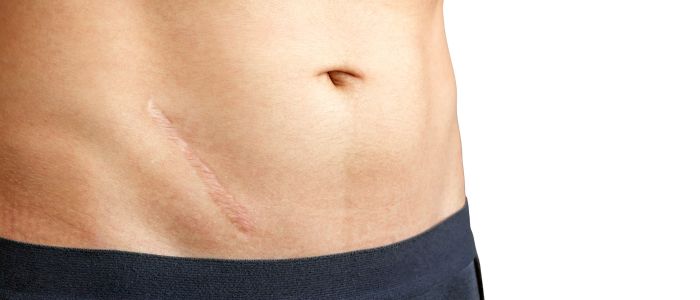
Table of Contents
- Want to Know How to Fade or get Rid of Old Scars?
- What are Hypertrophic Scars?
- What are Acne Scars?
- How do Scars form and mature?
- Different Types of Scars
- Poor scars can present in many forms:
- Options for Treatment of Long-Standing Scars
- Advanced Surgical Techniques for Scar Revision
- Comparative Analysis of Treatment Options
- FAQs about How to Get Rid of Long-standing Marks
- Further Reading about Skin and Scar Surgery
Want to Know How to Fade or get Rid of Old Scars?
Scarring can result from a variety of causes, including: accidents, injuries and cancer. In general, a scar will form following injury to the skin, when it becomes cut or torn. This can be accidental, or from having had surgery.
Scars can appear differently, depending on their cause. Typically, skin mark will be lighter in tone to the surrounding skin, also being softer in texture.
The individual appearance of a skin mark will depend on the severity of the injury, as well as how much tissue was removed or destroyed. This can also determine its particular size, shape and colour. With fair skin, most skin prints will begin red or purple in colour, before fading to become much paler in tone. For those with darker skin, scars will often look grey.
Scars may also be caused by inflammation of tissue, such as with acne when the marks left on the skin look flat or pitted, and may also be accompanied by discolouration of the skin.
There are different types of scarring which may differ depending on the way the skin became damaged. Contracted marks where skin stretches and tears are commonly caused by burns. This type of scarring may also go deeper, affecting muscles and nerves.
What are Hypertrophic Scars?
Hypertrophic scars are raised, red marks that are often formed from too much collagen being sent to the damaged site. These skin marks will often continue to grow outside of their boundary. Keloid scars are similar to hypertrophic scars but do not go beyond the boundary of the injury.
What are Acne Scars?
If you’ve had severe acne, you’re likely to develop pockmark, ranging from deep pits to skin print that are angular or wavelike in appearance. When prints form after surgery, they’re likely to be fineline prints that are straighter and neater in appearance.
How do Scars form and mature?
A scar forms when the skin tissue gets damaged, either accidentally or as a result of surgery.
Any break in the skin triggers a complex healing process, with collagen playing the main role together with a multitude of other proteins. Over the following months, the wound will continue to produce collagen accompanied by an increase in blood supply, which can result in the wound forming a print that is lumpy, red and raised. Generally, it takes up to 18 months for a scar to settle down and achieve its final appearance.
Whilst the ideal scar is a fine pale line, poor scarring may occur either due to genetic factors (the way each individual scars up) or factors such as trauma, infection or delayed wound healing.
Different Types of Scars
Poor scars can present in many forms:
- Wide (stretched) scars
- Hypertrophic scars (thick, raised scars) are a self-limited type of over-healing after tissue injury which usually regresses with type; the skin mark generally fades in colour and flattens to the surrounding skin level
- Keloid scars – marks that overgrow the original wound edges; they are raised, appearing as a growth on top of the skin, deeper in colour and can be uncomfortable and itchy
- Sunken or pitted skin prints – caused by the loss of fat under the skin, which can distort the surrounding tissues
The appearance of a scar can cause a person to feel self-conscious and wanting to keep it covered. Whilst there are several non-surgical ways available to treat poor marks, if all other attempts to improve the print appearance does not prove effective enough, skin surgery for surgical scar revision may be an appropriate option.
Options for Treatment of Long-Standing Scars
Treatment for a skin marks will depend on the type of scarring. In some cases, an aesthetic treatment such as dermal fillers can be used to help smooth the appearance of the skin. This method is often effective on acne scarring, but will only provide a temporary solution.
At Chester Cosmetic Surgery we can perform both aesthetic treatments as well as surgical procedures for the revision of scars. Surgically, scars may be reopened to encourage improved regrowth of scar tissue, thus improving the overall size and shape.
Advanced Surgical Techniques for Scar Revision
Scar revision surgery has come a long way, with many advancements allowing for more effective and less invasive procedures. Among the most notable are laser surgery, micro-needling, and surgical scar excision, each tailored to different types of scars and patient needs.
Laser surgery is increasingly popular for its precision and the ability to target different layers of skin without invasive cutting. Different types of lasers, such as ablative and non-ablative lasers, can be used depending on the scar’s characteristics. Ablative lasers work by vaporising the upper layers of damaged skin, prompting the body to produce new, healthier tissue. On the other hand, non-ablative lasers focus on the underlying skin tissue, promoting collagen production without damaging the surface.
Micro-needling, another minimally invasive technique, involves using fine needles to puncture the skin and stimulate collagen production. This procedure is particularly effective for atrophic scars, such as those from acne or chickenpox, as it helps to elevate the depressed areas.
Surgical excision is reserved for more severe cases, such as hypertrophic scars and keloids, which do not typically respond well to less invasive methods. In this procedure, the scar is surgically removed, and the skin is sutured or grafted to heal in a more controlled and aesthetically pleasing way. New techniques in this area include the use of precision cutting tools and improved suturing techniques that minimise the risk of new print formation.
Comparative Analysis of Treatment Options
When it comes to choosing a scar treatment method, it’s essential to consider the type of scar, its location, and your skin type. Here’s a detailed comparison of popular treatment options:
- Laser Therapy: Ideal for both hypertrophic scars and fine lines, laser therapy can minimise the appearance of skin prints by smoothing out the skin and reducing redness. It’s particularly effective for facial scars where precision is crucial. However, you may need several sessions, and there’s a risk of hyperpigmentation, especially in darker skin tones.
- Surgical Revision: This method is suitable for large or very prominent marks that do not respond well to other treatments. It offers a permanent solution but comes with risks such as infection and the potential for new skin mark formation. Recovery time can also be significant, depending on the surgery’s extent.
- Injectable Fillers: For atrophic scars, injectable fillers can provide a quick fix by elevating the depressed skin mark tissue. The results are immediate, though temporary, and treatments need to be repeated periodically. Fillers are less effective for hypertrophic or keloid scars.
- Corticosteroid Injections: Used primarily for hypertrophic or keloid scars, these injections can reduce skin mark size and alleviate symptoms like pain and itchiness. The treatment requires multiple sessions and may not be as effective for older or larger skin marks
- Silicone Sheets and Gels: Often used as an initial treatment option, silicone products can hydrate and protect the mark, helping to reduce size, colour, and texture. They are non-invasive and inexpensive, suitable for all scar types but require consistent, long-term use for the best results.
- Cryotherapy: Effective for smaller keloid marks, cryotherapy involves freezing the print tissue to reduce its size. While it can be very effective, there’s a chance of skin discoloration and not suitable for larger prints.
Each of these methods has its pros and cons, and often, a combination approach may be necessary to achieve the best results. The choice of treatment should be guided by a thorough evaluation from a plastic surgeon like Consultant Plastic Surgeon Anca Breahna who can recommend the most effective options based on your specific conditions and expected outcomes.
FAQs about How to Get Rid of Long-standing Marks

How long does it take to see results from scar treatments?
Results can vary based on the treatment type and the scar’s characteristics. Some treatments like laser therapy may show improvements within a few weeks, while surgical options might take several months for the full results to be evident.
Can scar treatments completely remove a scar?
Most treatments aim to significantly reduce the visibility of scars but may not completely remove them. The success of skin mark minimisation depends on factors like the age of the scar, the treatment method chosen, and individual healing processes.
Are there any risks associated with scar removal treatments?
Yes, like all medical procedures, scar treatments come with potential risks. These can include infection, changes in skin colour, or further scarring. It’s important to discuss these risks with Anca before beginning treatment.
What can I do to support healing after a scar treatment procedure?
Following post-treatment care instructions closely, such as keeping the treated area clean, avoiding sun exposure, and applying recommended creams or gels, can support better healing outcomes.
How do I choose the best treatment option for my scar?
Consulting with a plastic surgeon like Consultant Plastic Surgeon Anca Breahna is the best way to determine the most effective treatment for your skin print type and skin condition. Anca can provide personalised advice based on the latest treatments available and your specific health needs.
Medical References for Old Scars
Further Reading about Skin and Scar Surgery
-
- Read Anca’s Procedure Page about Scar Revision Surgery
- Read Anca’s Procedure Page about Effective Scar Treatment
- Read Anca’s Blog About Treatments for Scars






